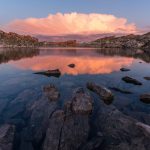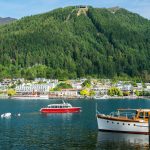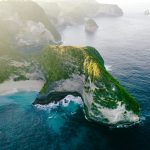Table of Contents
After spending six months hiking through Patagonia’s wildest corners, I discovered routes that never make it to Instagram – places where condors still outnumber people and glaciers crash into lakes while no one’s watching.
1. The Secret Circuit, Tierra del Fuego
Everyone knows about Torres del Paine’s W Circuit, but few venture into this hidden gem at the end of the world. This three-day loop circles around mountains so jagged they look like dragon teeth. I watched a family of Andean foxes play in a field of wild orchids while condors soared overhead.
The local rangers showed me a detour to an unmarked valley where wild horses still roam free. Time your hike for December when the southern hemisphere’s summer brings 18 hours of daylight and carpets of wildflowers. Ask for Pedro at the ranger station – he knows where the resident puma family makes their morning rounds.
2. Cerro Castillo Hidden Route, Chile
Picture the drama of Torres del Paine without the crowds. This four-day trek winds through forests of southern beech trees and past turquoise lakes. But here’s what the guidebooks don’t tell you: there’s a secret thermal river halfway through where you can soak your tired feet while watching ice fall from hanging glaciers.
The locals taught me their weather-reading tricks: when the caracara birds fly low, storms come within hours. Pack extra socks and hit the trail before sunrise – that’s when the morning light turns the castle-like peaks golden, and you might spot the rare Andean deer coming to drink from the lakes.
3. Huemul Circuit, Los Glaciares
This might be the only hike in the world where you have to use a harness to pull yourself across rivers in a homemade zipline. Most people skip it because of the technical parts, but that’s exactly why it’s perfect. I camped beside massive glaciers that calved all night, the thunder of falling ice my only companion.
Bring a good camera – the Southern Patagonian Ice Field views are better than any helicopter tour could offer. The local guides never tell tourists about the hidden hot spring near camp three, but if you befriend them over mate (local tea), they might share the GPS coordinates.
4. Valle Aviles, Chile
A valley so remote it doesn’t appear on most maps. The only way in is a shepherd’s trail that the Aonikenk people used for centuries. I shared the trail with guanacos and found rock paintings that my guide said even archaeologists haven’t documented yet. The wind here blows so strong it can lift your backpack – but the views make every step worth it.
Time your visit for autumn when the southern beech forests turn crimson and gold. The local gauchos know a natural rock shelter with ancient handprints on the ceiling. Bring them mate, and they might show you their secret camping spot with views of three different glaciers.
5. Sendero Fitz Roy Norte, Argentina
Everyone photographs Fitz Roy from the famous lake, but this northern approach offers views that never make it to social media. The trail follows old hunting paths used by pumas, and if you’re quiet (and lucky) like I was, you might spot one drinking from a glacier stream.
Camp at the hidden lagoon on the north face – the sunset turns Fitz Roy’s granite walls blood red, reflected perfectly in the waters so still they look like glass. The locals call this the “photographer’s secret,” and now I know why. Pack a good tent; the infamous Patagonian winds are strongest here.
6. Paso del Viento, Argentina
Walk on the world’s third-largest ice field without needing technical climbing skills. This trail disappears into clouds, hence the name “Wind Pass.” But here’s the secret – most hikers turn back at the first glacier view. Push two hours further and you’ll find ice caves that glow blue from within.
The local mountain guide, Carlos, showed me how to read the ice: blue means stable, white means stay away. Time your visit for November when the spring melt creates natural ice bridges. And pack waterproof everything – the infamous Patagonian weather can give you four seasons in four minutes.
7. Reserva Parque Patagonia, Chile
A former estancia (ranch) turned wilderness reserve where you can hike through valleys that haven’t changed since the last ice age. The trail connects ancient cave painting sites, and if you’re observant, you might spot fossils in the rock walls. I found a complete marine dinosaur vertebra just lying on the trail.
Stay at the Stone House camp – it’s basic but the host, Don Miguel, makes bread in an underground oven and knows where condors nest in the cliffs above. His mate’s recipe includes herbs that grow only on these slopes. Visit during the spring migration when flamingos stop at the high-altitude lakes.
8. Cabo Froward Trail, Chile
The southernmost trek on mainland America follows the coastline to a cross marking the continent’s end. Most people don’t attempt it because you have to time your hike with the tides. Get it right, and you’ll watch penguins surf waves onto black sand beaches while dolphins play offshore.
Pack lightweight because you’ll wade through rivers. The local fishermen know exactly when to cross each section – make friends at the last village and they might share their tide tables. The reward? Camping on beaches where the only footprints are yours and those of the southern sea lions.
9. Laguna del Desierto Circuit, Argentina
A forgotten trail that connects five hidden lakes, each a different shade of blue. The local rangers told me they find new waterfalls every season as the glaciers retreat. I stumbled upon a valley full of giant rhubarb plants that made me feel like I was hiking through “Honey, I Shrunk the Kids.”
The secret campsite isn’t marked on any map – look for the lightning-struck lenga tree near the second lake. That’s where you’ll get perfect sunrise views of the ice wall across the valley. Bring binoculars; Andean condors nest in the cliffs and put on acrobatic displays at dawn.
10. Valle Exploradores, Chile
A valley that lives up to its name, where new trails appear as glaciers retreat. The local ice climbers showed me a route to a cave where you can watch (and hear) a glacier move. The sound of ancient ice groaning is something between a whale song and thunder – otherworldly.
The best part? Hot springs under a hanging glacier. You have to scramble through a boulder field to find them, but soaking in hot water while watching ice crash into a turquoise lake is worth every bruise. Visit in late summer when ice caves form in the glacier’s base.
Beyond the Guidebooks
Someone recently asked if Patagonia’s lesser-known trails were worth the extra effort. That night, I watched the Milky Way reflect in a glacier lake while wild horses grazed nearby and the Southern Cross hung above jagged peaks no photographer had captured. Some questions answer themselves.

I’m Garrett, a seasoned photojournalist with a passion for uncovering the world’s hidden treasures. My journey is fueled by a deep curiosity for diverse cultures and breathtaking landscapes. When I’m not behind the lens capturing the world’s wonders, you can find me exploring underwater realms or sharing my passion for discovery with my two adventurous children.




